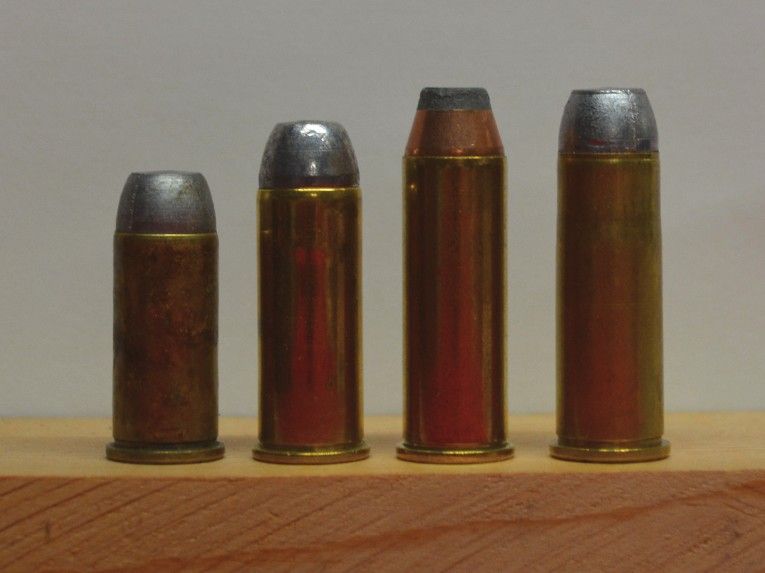Howdy
Quite a story, glad you survived.
Here is a photo of four different 44 caliber revolver cartridges.
From left to right they are 44 Russian, 44 Special, 44 Magnum, and 44-40.
The 44 Russian is the oldest cartridge here, it dates from around 1871 when Smith and Wesson had a contract with Russia and eventually supplied about 150,000 revolvers to the Czarist government. The Russians specified the design of the cartridge, it originally held about 23 grains of Black Powder and fired a soft lead 256 grain bullet. Muzzle velocity from a 7" barrel would have been around 700 feet per second.
The next cartridge in line is the 44 Special, sometimes also known as the 44 S&W Special. Smith and Wesson introduced this cartridge in 1908 with a newly designed revolver sometimes known as the Triple Lock. The 44 Special is basically the same cartridge as the 44 Russian, all dimensions are the same with the exception that the brass case is about 1/10" longer. Because the case was slightly longer, the 44 Special held slightly more Black Powder, about 26 grains. Soon after it was introduced the powder used in the 44 Special cartridge was changed over to modern Smokeless Powder. Muzzle velocity of modern 44 Special ammunition can vary widely from 700 feet per second up to about 900 feet per second. Modern bullets vary in weight too, from about 200 grains to about 250 grains.
The third cartridge from the left is a 44 Magnum. This is a devastatingly powerful cartridge. It was introduced in 1955 by Remington for a new revolver developed by Smith and Wesson. This cartridge and revolver were made famous in the 1971 Clint Eastwood movie Dirty Harry. At the time it was the most powerful handgun cartridge in the world. The round pictured is a Remington round with a 180 grain Jacketed Soft Point bullet. The advertised velocity is 1610 feet per second.
The 44-40 cartridge all the way on the right is from a different family of cartridges. The name refers to the fact that the bullet was 44 caliber, and the cartridge originally held 40 grains of Black Powder. The 44-40 is also known as the 44 WCF which stands for 44 Winchester Center Fire. This cartridge was introduced by Winchester in 1873 for the Model 1873 lever action rifle. In 1878 Colt chambered the Single Action Army revolver for the 44-40 cartridge. Many revolvers and rifles were chambered for the 44-40 over the years, but until recently it was pretty much an obsolete cartridge without many commercial sales. That changed a few years ago when Western style shooting became popular and 44-40 is again available as loaded ammunition. 44-40 bullets can vary in weight from about 200 grains to about 225 grains. Velocity can vary from about 700 feet per second up to about 900 feet per second.
I suspect the cartridge that was used against you was probably a 44 Special.
44 Russian is pretty outmoded and although it is being commercially loaded again, and it can be fired in any revolver that will fire 44 Special or 44 Magnum, it is not commonly available very many places.
44 Magnum is so powerful that I doubt you would have survived a chest wound from it.
44-40 is pretty much a specialty cartridge today, and although there were many rifles and revolvers chambered for it over the years, commercially loaded ammunition is not commonly available over the counter. Also, 44-40 ammunition cannot be fired in a firearm chambered for any of the other three cartridges we have discussed.
Although there are not many revolvers chambered for 44 Special any more, there were many thousands of them built over the years, and any modern 44 Magnum revolver will also fire 44 Special ammunition. There are still a few relatively inexpensive, short barreled revolvers being made that are fairly easy to conceal and are specifically designed to fire the 44 Special cartridge.
There were other early 44 caliber revolver cartridges such as the 44 Henry, 44 S&W American, and the 44 Colt, but those are all antique cartridges for antique firearms and I doubt a modern criminal would have used a firearm chambered for one of these cartridges.

